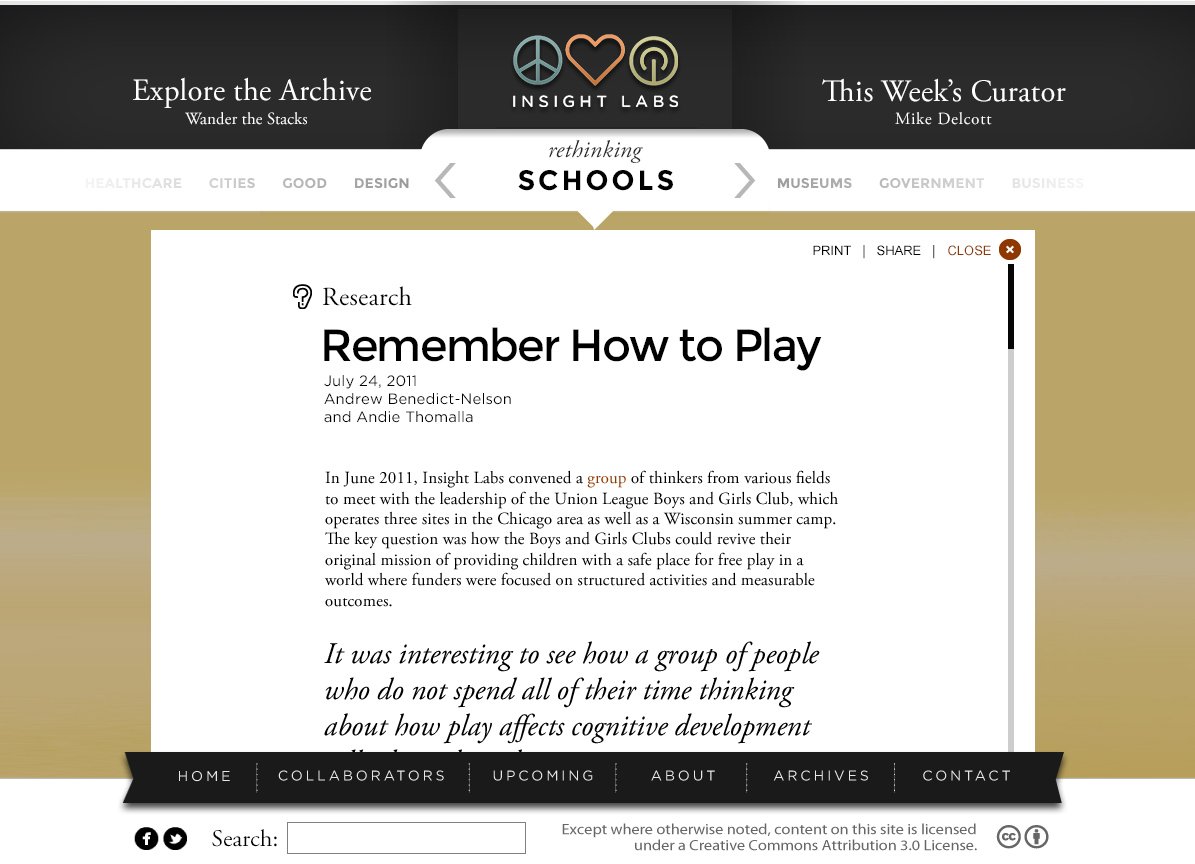Insight Labs
Website and brand
Collectively, we have it backwards. The vast majority of our amassed intelligence and imagination is consumed by commerce, from grand efforts to build wealth to granular activities like selling movie tickets and deodorant. While we donate some time and treasure, efforts that serve the greater good are severely undermanned.
Our work is based on four beliefs: groups that serve the greater good - and not just organizations that pay us - deserve our best thinking; new truths emerge from collisions of multiple perspectives, multiple experiences, in confined quarters; creativity and innovation emerge when you kill posturing and politics; and one shared vision is more meaningful and more powerful than an ocean of good ideas, even if the shared vision isn't perfect.
“Insight Labs lures the smartest, most creative, most influential people out of boardrooms and darkened auditoriums to get them engaged in designing a better world.”
Strategy: INTELLIGENS CONSILIUM
A fundamental problem with new models is that people, when learning about a new model, tune out the explanation and instead fit what they’ve heard into a framework they already understand. It’s human nature, first chronicled in 1880 and now a standard element of information theory.The vast majority of people who engage with Insight Labs will do so solely through the Labs website. So it is essential that the site clearly and immediately communicate new interests, new findings and a new modus operandi - before previously held assumptions color a visitor’s experience.
Purpose of themes
This turned out to be the hardest question to answer. The Lab’s themes are pages where pieces of content - organized by ideas, like the sections of a library or bookstore, rather than by date or people or organization.
We resolved that the themes should be ways for visitors to choose their own adventures, to sort through big ideas until they find a place to start following a trail. In other words, Macy's windows. The themes are NOT a way to understand the whole of the Lab’s work, but a way to begin journeys through the work. Macy's does have an inventory system - but the windows are different.
We chose these particular 8 themes because we can imagine our current and future audience being drawn to these “windows.” They are neither exhaustive (some content will not fit neatly into any of them,) nor are they exclusive (some content will overlap multiple themes,) and they are not entirely logical:
rethinking schools
rethinking museums
rethinking government
rethinking business
rethinking healthcare
rethinking cities
rethinking good
rethinking design
Navigation design centered around exploring content themes.
Next, we focused on developing a visual language and pattern around the Insight Lab’s output. Broadly speaking, this meant creating consistent ways to capture and present content according to the type of media it consisted of and its significance in the process.
Communicating media types is an already well-established pattern on the web, but the process of rethinking a topic at Insight Labs was somewhat unique:
Research
Labs
Insights
Outcomes
Imagery
To support the intellectual depth of the site’s textual content, we thought that it was imperative that imagery be selected that was provocative and unfamiliar–giving the reader a sense disoriented curiosity.
We sourced imagery for each of the eight theme pages, as well as a few works that could be used sparingly in other areas where visual elements could serve the conversation.
Creative Team
Ayesha Wadhwa-Mathews - Principal
Alan Zimmerman - Design
Development Team
Justin Baker - Assemblyco.com

















